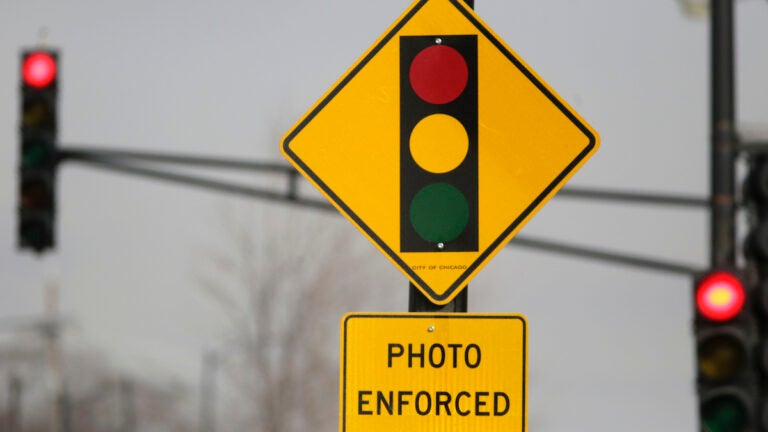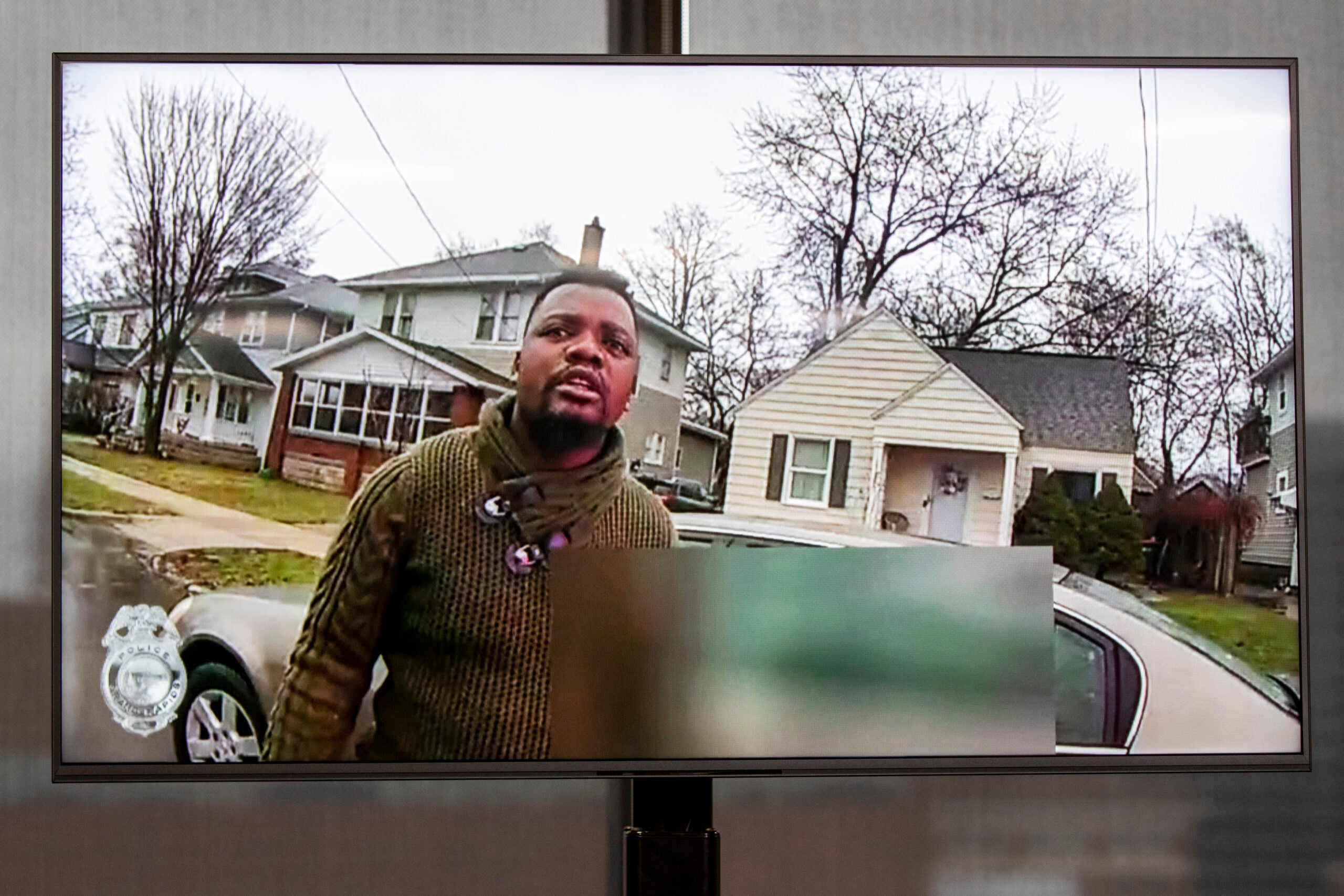Are There Red Light Cameras In Massachusetts
A beak to allow ruddy light cameras is heading to the Mass. Senate flooring. Here'due south how the arrangement would work.
"The crush of traffic makes it impossible for local police to adequately enforce the traffic laws ... Automatic enforcement using traffic cameras tin help."

Massachusetts drivers may want to practice pumping the brakes.
A bill to allow communities to install traffic enforcement cameras — ones that would snag shots of a commuter running a red light, for instance — is heading to the land Senate floor for a fence next week.
If passed, "An Act Relative to Automated Enforcement" would pave the way for cameras to automatically fine drivers snapped speeding, blocking the box, making illegal right turns, breezing past school double-decker stop signs, or failing to end on red.
An amended version has been put forth by the Senate Means and Means Committee. The legislation is slated to go earlier the Senate on February. 27.
"In many municipalities today, the beat of traffic makes it impossible for local police to adequately enforce the traffic laws," state Sen. Will Brownsberger, who filed the original beak, wrote on his website. "Route safety is deteriorating equally too many motorists push carmine lights, exceed speed limits on residential streets and block congested intersections. Automatic enforcement using traffic cameras can help."
The Belmont Democrat says the bill addresses two master concerns that stem from automated traffic enforcement: that violations recorded past cameras would take a chance individual privacy and that cities and towns would use the arrangement in "unreasonable means to make money."
Here'southward how the law would work in practice:
What cameras would — and wouldn't — record
The law would grant each city and town the ability to determine whether to install a camera or cameras based off its respective population (more on that subsequently).
Locations could include roads owned by municipalities or those owned by the country, in which case officials would need to obtain permission from country agencies, co-ordinate to the bill. Local governments tin can also braze the gadgets to schoolhouse buses.
Regardless, route signs must allow drivers know they're on camera.
And then what exactly constitutes a ticket-able offense?
- Running a solid crimson light
- Making a right turn on a ruddy light where prohibited
- Speeding (exceeding five miles per 60 minutes over the posted limit)
- Blocking an intersection
- Driving in a bus lane
- Passing a school bus when its finish sign is deployed and its lights are activated
There are, however, a number of exceptions.
According to Brownsberger, instances that would not be a fineable offense include:
- Drivers who committed a violation to steer articulate of emergency vehicles or to comply with some other law.
- Motorists participating in a funeral procession.
- If "any part of the vehicle was in the intersection when the lite turned xanthous" before a cherry light.
- If a driver went less than five miles per hour over the speed limit.
- If a driver did not cantankerous the plane of a school bus end sign when it was deployed.
- If the entire vehicle did non cross the stop line when making an illegal correct plow on a reddish lite.
- If the entire vehicle was not in an intersection, in the case of a driver blocking an intersection.
- If the vehicle involved was reported stolen at the time of the crime.
- If a motorist also receives a moving violation ticket from a traffic officeholder.
If a rental vehicle is involved in a violation, the company that owns the vehicle is required to provide officials with the information of the person who was renting it at the fourth dimension so that he or she can exist sent the ticket, according to the bill.
What fines would price — and how the process would play out
Fines generated by cameras would be capped at $25 per violation, according to the legislation — even for speeding.
Since cameras would place alleged violators past license plates, tickets would exist sent to the owner of each vehicle. Notices would be required to be sent inside 2 weeks of the violation and must include a photograph of the incident and all relative information, including date, fourth dimension, and location.
Ticketed drivers could either pay the fine or appeal it. They would have 60 days to contest the ticket.
If an possessor acquires 5 unpaid or unresolved violations, the Registrar of Motor Vehicles cannot renew the vehicle's registration, Brownsberger wrote.
What limits the constabulary would impose on cameras and the organization at large
Not every city or town would be able to install a photographic camera in their community.
The neb mandates that municipalities could simply install one camera per every 2,500 residents, which means that, in the state'due south smallest towns, cameras would non be immune at all. Schoolhouse bus cameras are not included in the limit.
Furthermore, the law would require local leaders to approve each camera and its location simply after they've held a public hearing. Cities and towns must likewise roll out a public sensation entrada at least thirty days before a camera is installed, co-ordinate to the neb.
Brownsberger writes that cameras tin just charge drivers for the violations outlined in the law, and municipalities must "transfer any net profits from the use of cameras to the state" and submit an almanac report to the Department of Transportation on the employ of cameras in their corresponding communities.
The bill "very tightly limits the exposure of motorists and includes other provisions to assure that municipalities will non overuse the new tool," he wrote.
Co-ordinate to Brownsberger, violations cannot create surcharges on a vehicle owner's insurance, and as well cannot get office of the owner's Registry of Motor Vehicles record.
He too says the legislation is crafted to protect individual privacy through several mechanisms.
Cameras, for example, can merely take photos of the rear of a vehicle and, "to the extent practicable, additional efforts will exist fabricated to avoid capturing identifiable images of the occupants or contents of the vehicle," Brownsberger wrote.
"Information derived from the photographic camera may not be used by the photographic camera vendor for whatsoever purpose other than enforcing violations," he added.
Photographs cannot exist used in any court proceeding exterior of a related ticket hearing without a court society. The images would also not be considered public record and, inside 48 hours later a ticket is tending, the snapshots would exist destroyed.
Pictures could only exist taken when a violation occurs.
Why the cameras have become necessary, according to the bill'due south sponsor
When Brownsberger was pushing for automated traffic enforcement in 2018, he wrote that the concept could reduce vehicle crashes, just said it also faced legal and political barriers.
"Implementation of automated enforcement requires land legislation to define a new procedure for attaching fines to violations," he wrote on his website at the fourth dimension. "The legal problem is that, in the absenteeism of an officer pulling someone over, it is incommunicable to know who was driving the vehicle. So, we would have to concord the vehicle owner responsible, just there is no current mechanism to do that for moving violations."
Withal, Brownsberger recently pointed to the fact the Centers for Illness Control and Prevention see these mechanisms equally a public wellness intervention.
He besides contended that with express law resources "millions of traffic violations become undetected or ignored every day on the roads of the Commonwealth."
"People concerned about over-enforcement and the 'big brother' aggregating of data often too raise questions nearly how effective the tools are in changing behavior," Brownsberger wrote in 2018. "In my mind, the effectiveness depends on practical decisions made in the roll-out. Where are the cameras placed? To what extent do drivers have accelerate warning? Information technology seems beyond reasonable dispute that a good implementation with fair enforcement goals could change behavior in positive ways."
Conversation
This discussion has concluded. Please bring together elsewhere on Boston.com
Source: https://www.boston.com/news/policy/2020/02/21/bill-red-light-cameras-massachusetts-senate/
Posted by: higginbothamfacking.blogspot.com


0 Response to "Are There Red Light Cameras In Massachusetts"
Post a Comment